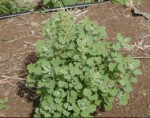Scientific Name: Chenopodium oahuense
Endemic: Kauai, Oahu, Molokai, Maui, Lanai, Hawaii, plus Lisianski, Laysan, Necke, French Frigate Shoals, Nihoa.
With all the news about people fishing for ‘Aweoweo (Priacanthus spp.) at He’eia pier and all over the islands a few years ago, I thought it would be interesting to share with people information of this Hawaiian plant with the same name. If you’re wondering why a fish and a plant would have the same Hawaiian name then you must go all the way back to the beginning: The Kumulipo. In this Hawaiian creation chant many things are created in a dualistic manner meaning that when one thing is created in the ocean, there is often a counter part created on land or in the air or both!
Description: ‘Aweoweo are typically low shrubs to small trees 2-8ft. tall with light blue/green leaves that are in the shape of a goose’s foot (they belong to the goose foot plant family Chenopodiacae). Sometimes the leaves call be very tiny, about ¼”-1/2″ across or they can be up to 2 inches depending on the growing conditions. Usually less water and more sun will result in smaller, thicker leaves whereas regular watering will make the plant have larger more thin leaves like in the picture. The flowers are very small and are in clusters above the plant. The older stems are usually streaked with red, similar to the fish, but also, when the leaves and flowers are crushed it smells just like the ‘aweoweo fish too! fo’ real! I not joking! But, you have to crush it first. You don’t have to worry about the plant smelling up your yard.
Distribution: ‘Aweoweo, the plant not the fish, is found in drier, harsh habitats like near the ocean, in the lowland dry forest or all the way up in the sub-alpine shrub land of the large volcanoes like Mauna Kea. Although its species name is oahuense, this endemic plant is found on all of the main Hawaiian Islands except Kaho’olawe (it was probably found there before) but also on most of the Northwestern Hawaiian islands as well.
Landscape use and care: This plant is bullet proof! It likes full sun, and little to no watering once established. There are also hardly any bugs that attack this plant either. Sometimes you may notice some scale or aphids but this can be easily removed by hand or by spraying off with water.
Cultural Uses: The young leaves and stems are wrapped in ti leaves and steamed to be eaten in times of famine. The harder wood at the base of the plant can also be shaped in to fish hooks so you can catch ‘aweoweo with ‘aweoweo.
Additional Info: Other names for this plant include: ‘Aheahea, ‘ahea, ‘ahewahewa, alaweo, alaweo huna (Ni’ihau), kaha’iha’i.
Aweoweo







